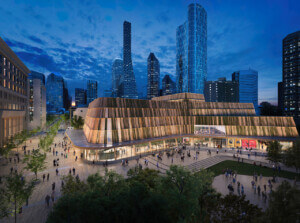A new architectural era is dawning at Boston University (BU) with the announcement of the building of the Data Sciences Center on the university’s main Charles River campus. First, it is a bit of design daring not commonly seen in Boston: a ziggurat-shaped tower with multiple cantilevers that will be the tallest building on campus. But moreover, it represents a break from the past for an institution that eschewed contemporary architectural patronage for more than two generations.
“It’s like a spark plug that jumps out at you,” said Bruce Kuwabara, a partner in KPMB Architects of Toronto, designers of the building. “BU wanted to make a statement.” Gary Nicksa, BU’s senior vice president for operations, concurred, adding: “The city has embraced the idea of more remarkable architecture at BU.”
A little background is in order. John Silber, president of the university from 1971 to 1996 and from 2002 to 2003, was an academic curmudgeon whose conservative politics were matched by his disdain for cutting-edge architecture. He even wrote a manifesto of sorts, a book titled Architecture of the Absurd, in which he excoriated his fellow college presidents for commissioning the likes of Frank Gehry and Steven Holl to design eye-catching buildings, singling out Massachusetts Institute of Technology (Stata Center by Gehry, Simmons Hall by Holl) for special scorn.
But that was then, this is now. For this new landmark, BU invited a number of top architects to submit quals and then narrowed the field down to five: KPMB, Safdie Architects, Kohn Pedersen Fox, Bohlin Cywinski Jackson, and Elkus Manfredi Architects. BU officials visited works by many of the architects, taking a field trip to Toronto to view KPMB’s.
Kuwabara described the KPMB scheme as a “vertical campus” that celebrates the importance of data science by bringing together the mathematics and statistics departments and the computer science department under one roof. The architect said the building’s spaces “spiral” around an interior atrium that is all about spontaneous encounters with colleagues and students that are essential in the data sciences field.
“You need a building that encourages collisions,” Kuwabara said.
The cantilevered and stepped massing yields several advantages. It forms balconies and green roofs that allow occupants fresh air and stunning views of the Boston skyline and Charles River. It will cause a play of light and shadow. And, significantly, it will appear to be a beehive at night, with loft-like interior spaces highly conducive to work and creativity 24/7.
The choice of some materials is still a work in process. At present, the rust-colored cladding is specified as terracotta panels, but that could change, Kuwabara said. But whether terra cotta or metal, he says, it will be aesthetically compatible with the ubiquitous red brick found throughout Boston.
Without specifically stating it, it is clear that BU wants a new architectural profile commensurate with those of Harvard University and MIT.
“This will get noticed across the river,” Kuwabara said.











